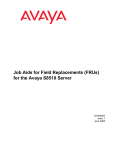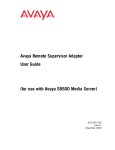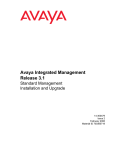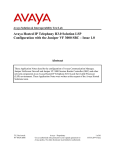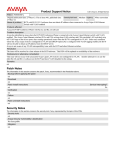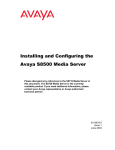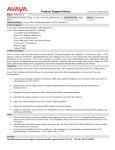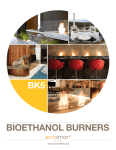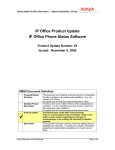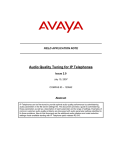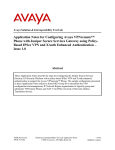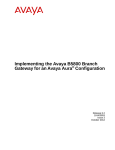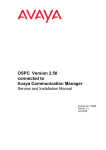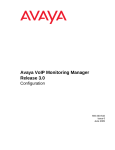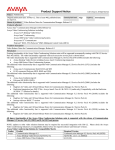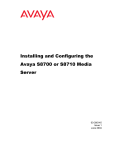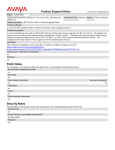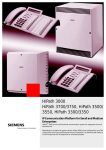Download Avaya Remote Feature Activation Getting Started with Remote Feature Activation (RFA) User's Manual
Transcript
Remote Feature Activation Getting Started with Remote Feature Activation (RFA) 03-300484 Issue 2.4 June 2006 Contents About this book . . . . . . . . . . . . . . . . . . . . . . . . . . . . . . . 7 What’s new in this version of Getting Started With RFA?. . . . . . . . . . . . . . 7 Audience . . . . . . . . . . . . . . . . . . . . . . . . . . . . . . . . . . . . . . . . 7 Downloading this book and updates from the Web . . . . . . . . . . . . . . . . . Downloading this book . . . . . . . . . . . . . . . . . . . . . . . . . . . . . . 8 8 Conventions . . . . . . . . . . . . . . . General . . . . . . . . . . . . . . . . Typography . . . . . . . . . . . . . Commands . . . . . . . . . . . . User input . . . . . . . . . . . . System output and field names . . . . . . . 8 8 8 9 9 9 Trademarks. . . . . . . . . . . . . . . . . . . . . . . . . . . . . . . . . . . . . . . 9 Trademarks and Service Marks . . . . . . . . . . . . . . . . . . . . . . . . . . . . . . . . . . . . . . . . . . . . . . . . . . . . . . . . . . . . . . . . . . . . . . . . . . . . . . . . . . . . . . . . . . . . . . . . . . . . . . . . . . . . . . . . . . . . . . . . . . . . . . . . . . . . . . . . . . . . . . . . . . . . . . . . . . . . . . . 10 Technical assistance . . . . . . . . . . . . . . . . . . . . . . . . . . . . . . . . . Within the United States. . . . . . . . . . . . . . . . . . . . . . . . . . . . . . International . . . . . . . . . . . . . . . . . . . . . . . . . . . . . . . . . . . . 11 11 11 Sending us comments. . . . . . . . . . . . . . . . . . . . . . . . . . . . . . . . . 12 Chapter 1: Remote Feature Activation Overview . . . . . . . . . . . . . 13 User requirements . . . . . . . . . . . . . . . . . . . . . . . . . . . . . . . . . . . 13 Design configuration . . . . . . . . . . . . . . . . . . . . . . . . . . . . . . . . . 14 Reliability and availability . . . . . . . . . . . . . . . . . . . . . . . . . . . . . . . 14 Registration . . . . . . . . . . . . . . . . . . . . Registration for Avaya Associates . . . . . . Registration for Avaya BusinessPartners . . Group Authorization Identification (GAI) . . . . . 14 14 15 16 Training . . . . . . . . . . . . . . . . . . . . . . . . . . . . . . . . . . . . . . . . . 16 Feature Keywords . . . . . . . . . . . . . . . . . . . . . . . . . . . . . . . . . . . Value types . . . . . . . . . . . . . . . . . . . . . . . . . . . . . . . . . . . . . 16 17 Host IDs and serial numbers . . . . . . . . . . . . . . . . . . . . . . . . . . . . . 17 RFA Swap-Out functionality. . . . . . . . . . . . . . . . . . . . . . . . . . . . . . 17 Pre-installation and application readiness checklist . . . . . . . . . . . . . . . . 18 RFA help . . . . . . . . . . . . . . . . . . . . . . . . . . . . . . . . . . . . . . . . 19 Chapter 2: Important Product Information . . . . . . . . . . . . . . . . . 21 Advanced IP Phone Features . . . . . . . . . . . . . . . . . . . . . . . . . . . . . Advanced IP Phone Features license file information . . . . . . . . . . . . . 21 22 . . . . . . . . . . . . . . . . . . . . . . . . . . . . . . . . . . . . . . . . . . . . . . . . . . . . . . . . . . . . . . . . . . . . Issue 2.4 June 2006 3 Contents Application Assurance Networking . . . . . . . . . . . . . . . . . . . . . . . . . Application Assurance Networking license file information . . . . . . . . . . 23 23 Application Design Environment . . . . . . . . . . . . . . . . . . . . . . . . . . . RFA licensed ADE components . . . . . . . . . . . . . . . . . . . . . . . . . ADE license file information . . . . . . . . . . . . . . . . . . . . . . . . . . . 25 25 26 Application Enablement (AE) Services. . . . Upgrading to AE . . . . . . . . . . . . . . Upgrading CVLAN R9 to AE. . . . . . . . Upgrading DEFINITY LAN Gateway to AE CVLAN Server 9.0 for Linux . . . . . . . . RFA licensed AE applications . . . . . . AE license file information . . . . . . . . . . . . . . . . . . . . . . . . . . . . . . . . . . . . . . . . . . . . . . . . . . . . . . . . . . . . . . . . . . . . . . . . . . . . . . . . . . . . . . . . . . . . . . . . . . . . . . . . . . 27 28 28 28 29 29 30 Branch Gateways . . . . . . . . . . . . . . . . . . . . . . . The serial number for the G250 or G350 Media Gateway Post installation verification . . . . . . . . . . . . . . . Activating the VPN. . . . . . . . . . . . . . . . . . . . . Branch Gateway license file information. . . . . . . . . . . . . . . . . . . . . . . . . . . . . . . . . . . . . . . . . . . . . . . . . . . . . . . . . . . . . . . . . . . . . 32 33 33 33 34 Communication Manager . . . . . . . . . . . . . Serial numbers for Communication Manager Working with authentication files. . . . . . . DEFINITY upgrades . . . . . . . . . . . . . . DEFINITY migrations . . . . . . . . . . . . . . . . . . . . . . . . . . . . . . . . . . . . . . . . . . . . . . . . . . . . . . . . . . . . . . . . . . . . . . . . . 34 35 35 36 36 The Shared Blade Server . . . . . . . . . . . . . . . . . . . . . . . . . . . . . . . 37 Interaction Center . . . . . . . . . . . . . . . . . . . . . . . . . . . . . . . . . . . E-mail license request and IC . . . . . . . . . . . . . . . . . . . . . . . . . . . IC license file information . . . . . . . . . . . . . . . . . . . . . . . . . . . . . 38 39 40 Integrated Management . . . . . . . . . . . . . . . . . . . . . . . . . . . . . . . . Integrated Management license file information . . . . . . . . . . . . . . . . 43 43 Meeting Exchange . . . . . . . . . . . . . . . . . . . . . . . . . . . . . . . . . . . Meeting Exchange license file information . . . . . . . . . . . . . . . . . . . 44 45 Modular Messaging . . . . . . . . . . . . . . Host ID information . . . . . . . . . . . . Post installation verification . . . . . . . Modular Messaging license information . . . . . 45 46 46 46 Personal WorkSpace . . . . . . . . . . . . . . . . . . . . . . . . . . . . . . . . . PWS licensing information . . . . . . . . . . . . . . . . . . . . . . . . . . . . 47 48 Security Gateway . . . . . . . . . . . . . . . . . . . . . . . . . . . . . . . . . . . Security Gateway models . . . . . . . . . . . . . . . . . . . . . . . . . . . . . Security Gateway license file information . . . . . . . . . . . . . . . . . . . . 48 49 50 . . . . . . . . . . . . . . . 4 Getting Started with Remote Feature Activation (RFA) . . . . . . . . . . . . . . . . . . . . . . . . . . . . . . . . . . . . . . . . . . . . . . . . . . . . . . . . . . . . . . . . . . . . . . . . . . . . . . . . . . . . . . . . . . . . . . . . . . . . . . . . . . . . . . . . . . . . . . . . . . . . . . . . . . . . . Contents SIP Enablement Services . . . . . . . . . . . . . . . . SIP Enablement Services module type. . . . . . . Post installation verification . . . . . . . . . . . . SIP Enablement Services license file information . . . . . . . . . . . . . . . . . . . . . . . . . . . . . . . . . . . . . . . . . . . . . . . . . . . . . . . . . . . . . 50 51 51 51 Softclients . . . . . . . . . . . . . . . . . . . . . . . . . . . . . . . . . . . . . . . Softclients Host ID information . . . . . . . . . . . . . . . . . . . . . . . . . . Softclients license file information . . . . . . . . . . . . . . . . . . . . . . . . 52 52 52 Unified Communication Center . . . . . . . . . . . . . . . . . . . . . . . . . . . . UCC Host ID information . . . . . . . . . . . . . . . . . . . . . . . . . . . . . UCC license file information . . . . . . . . . . . . . . . . . . . . . . . . . . . 53 54 55 Voice Self Service (VSS). . . . . . . . . . . . . . . . . . . . . . . . . . . . . . . . VSS Host ID information . . . . . . . . . . . . . . . . . . . . . . . . . . . . . VSS license file information. . . . . . . . . . . . . . . . . . . . . . . . . . . . 55 56 56 Glossary . . . . . . . . . . . . . . . . . . . . . . . . . . . . . . . . . . 59 Index . . . . . . . . . . . . . . . . . . . . . . . . . . . . . . . . . . 61 Issue 2.4 June 2006 5 Contents 6 Getting Started with Remote Feature Activation (RFA) About this book Note: Every attempt is made to ensure the accuracy of the contents of this document. However, many components are subject to change because of the evolving needs of the business. Note: The Getting Started With Remote Feature Activation (RFA) guide has been developed to provide information about RFA supported products in RFA. It is not intended to replace high-level technical information that is available from various documentation guides. This document is to be used by Avaya Services and Avaya BusinessPartners as an aid to: ● Understand the terms and procedures used in RFA ● Clarify the responsibilities of the RFA user ● Identify the browser requirements for accessing RFA ● Provide basic general directions for accessing and using RFA ● Provide information for each Avaya family supported by RFA Please read this Getting Started With RFA guide before attempting to implement a solution for an RFA supported product. What’s new in this version of Getting Started With RFA? Version 2.3 of the Getting Started With Remote Feature Activation (RFA) contains information on a new product family, Meeting Exchange. Audience This book is for the sales person, technicians, or other personnel requiring knowledge on RFA supported products. Issue 2.4 June 2006 7 About this book Downloading this book and updates from the Web You can download the latest version of this book from the Avaya Web site. You must have access to the Internet and a copy of Acrobat Reader. Avaya makes every effort to ensure that the information in this book is complete and accurate. However, information can change after we publish this book. Therefore, the Avaya Web site might also contain new product information and updates to the information in this book. You also can download these updates from the Avaya Web site. Downloading this book To download the latest version of this book: 1. Access the Avaya Support web site at http://support.avaya.com. 2. Click Find Documentation and Download by Product Name. 3. Click on the R in the alphabet list. 4. Select the document from the list. Note: Note: This book is only available in PDF format. Conventions This section describes the conventions used in this book. General The commands and screens are from the newest Avaya systems. The books referenced are the most current books at the time of this writing. You can substitute the appropriate commands for your system and see the books that you have available. Typography This section describes the typographical conventions for commands, keys, user input, system output, and field names. 8 Getting Started with Remote Feature Activation (RFA) Trademarks Commands ● Commands are in bold type. Example Type statuslicense and press Enter. ● Command options are in bold type inside square brackets. Example At the DOS prompt, type copybcf [-F34]. User input ● User input is in bold type, whether you must type the input, select the input from a menu, or click a button or similar element on a screen or a Web page. Examples - Type exit, and then press Enter. - On the File menu, click Save. - On the Network Gateway page, click Configure > Hardware. System output and field names ● System output and field names on the screen are in monospaced type. Examples - The system displays the following message: The installation is in progress. - Type y in the Message Transfer? field. Trademarks All trademarks identified by the ® or ™ are registered trademarks or trademarks, respectively, of Avaya Inc. All other trademarks are the property of their respective owners. Issue 2.4 June 2006 9 About this book Trademarks and Service Marks The following are trademarks or registered trademarks of Avaya: ● AUDIX® ● Cajun® ● Callvisor® ● Callmaster® ● CentreVu™ ● CONVERSANT® ● DEFINITY® ● DIMENSION® ● INTUITY™ ● MERLIN® ● MultiVantage™ ● Softconsole™ ● TransTalk® ● VOICE POWER® The following are trademarks or registered trademarks of Lucent Technologies: ● 5ESS™, 4ESS™ The following are trademarks or registered trademarks of AT&T: ● ACCUNET® ● DATAPHONE® ● MEGACOM® ● MULTIQUEST® ● TELESEER® The following are trademarks or registered trademarks of other companies: ● Acrobat® (registered trademark of Adobe Systems Incorporated) ● Ascend® (registered trademark of Ascend, Inc.) ● Audichron® (registered trademark of Audichron Company) ● MS-DOS® (registered trademark of the Microsoft Corporation) ● MicroChannel® (registered trademark of IBM Systems) 10 Getting Started with Remote Feature Activation (RFA) Technical assistance ● Microsoft® (registered trademark of Microsoft Corporation) ● MULTIQUEST® (registered trademark of Telecommunications Service) ● NetMeeting® (registered trademark of Microsoft Corporation) ● PagePac® (trademark of the Dracon Division of the Harris Corporation) ● PictureTel® (registered trademark of PictureTel Corporation) ● ProShare® (registered trademark of Intel Corporation) ● UNIX® (trademark of the Novell Corporation) ● Zydacron (registration pending for Zydacron Corporation) Technical assistance Avaya provides the following resources for technical assistance. Within the United States For help with: ● Feature administration and system applications, call the Avaya Technical Consulting System Support (TCSS) at, 1-800-225-7585 ● Maintenance and repair, call the Avaya National Customer Care Support Line at 1-800-242-2121 ● Toll fraud, call Avaya Toll Fraud Intervention at 1-800-643-2353 International For all international resources, contact your local Avaya authorized dealer for additional help. Issue 2.4 June 2006 11 About this book Sending us comments Avaya welcomes your comments about this book. To reach us by: ● Mail, send your comments to: Avaya Inc. Product Documentation Group Room B3-H13 1300 W. 120th Ave. Westminster, CO 80234 USA ● E-mail, send your comments to: [email protected] ● Fax, send your comments to: 1-303-538-1741 Be sure that you mention the name of this book, Avaya Getting Started With Remote Feature Activation (RFA). 12 Getting Started with Remote Feature Activation (RFA) Chapter 1: Remote Feature Activation Overview Remote Feature Activation (RFA) is a web-based application that is used to create and deliver license files for Avaya products. The license files are created using information from the customer and the SAP order.The SAP ordering information can be entered directly into SAP or Avaya and Avaya BusinessPartners can use the Order Messaging/OA Price Tool. User requirements To meet the requirements to access RFA you must: ● Be one of the following: - An Avaya associate or designee with a valid Avaya HRID number. This requirement also includes the Variable Workforce associates. - An approved BusinessPartner with a valid BusinessPartner number. - An approved Avaya contractor. This individual typically works for Avaya without a valid HRID number. ● Have a computer equipped with: - Internet Explorer 5.0 or later - 128 bit encryption - Internet access to the RFA web site - The supported monitor resolution of 800 X 600 ● Be registered and authenticated for each of the Avaya products in which you wish to create or modify a license file: - To be registered means you have been given a SSO (Single Sign On) login and are identified in the RFA database. - To be authenticated means that your coach or your Avaya Group Authorization Identification (GAI) manager has approved your access to RFA. For information on what a GAI is see Group Authorization Identification (GAI) on page 16. Issue 2.4 June 2006 13 Remote Feature Activation Overview Design configuration RFA does not provide design configurations. Avaya configurations must continue to be engineered using the existing tools and processes. The RFA process begins with an approved and accurate SAP order. A correct SAP order is key to the successful creation of the license file. Reliability and availability RFA has been designed for high reliability and high availability. RFA is normally available 24 hours a day, seven days a week. However, please be aware that there are factors that exist that will limit RFA availability for up to twelve hours at a time. These factors include maintenance, interactions with other systems that are not available, etc. The times for scheduled RFA outages are posted on the RFA Information page at http://rfa.avaya.com. Please check the RFA Information page regularly for the most current information. Note: Note: It is highly recommended that you create a license file as soon as you have all the needed information. Do not wait until the day of installation to obtain the license file. Registration This section explains how to register for RFA for Avaya Associates and BusinessPartners. Registration for Avaya Associates To log on to RFA you must have a valid Single Sign On (SS0) login and password. The SSO system provides access security for many Avaya applications, including RFA. You do not have to register for a SSO login if you are an Avaya associate. ! Important: Important: Check your personal information in RFA for accuracy. Make sure your POST information is correct. 14 Getting Started with Remote Feature Activation (RFA) Registration Complete the following steps to register in RFA for a product family: 1. Access the RFA web site at http://rfa.avaya.com. This link takes you to the SSO login site. 2. After you enter your SSO login and password the RFA Information page appears. 3. Click Register to Use RFA for a product family. 4. Select the product family from the drop-down menu: - Select the job function that most closely resembles the job function that you perform. You can find a detailed description for each job function on the RFA Information page under the RFA Job Function Descriptions link. - Complete the required information and click Submit. - Your coach automatically receives an e-mail that must be approved before you can become an RFA user. Registration for Avaya BusinessPartners To log onto RFA you must have a valid Single Sign On (SS0) login and password. The SSO system provides access security for many Avaya applications, including RFA. Make sure that your business card information is correct. The business card information is the same as your SSO information. Ensure that your e-mail address is accurate. You can update this information from the SSO login screen. Complete the following steps to register for a product family: 1. Access the RFA web site at http://rfa.avaya.com. This link takes you to the SSO login site. If you already have a SSO login, enter your login and password. If you do not have a SSO login, click New User and complete the required information. After you enter your SSO login and SSO password the system displays the RFA Information page. 2. Click Register to Use RFA for a product family and select the product family from the menu: 3. Select one of the following user types: - Tier 1 BusinessPartner if you purchase directly from Avaya. - Tier 2 BusinessPartner if you purchase from a Tier 1 BusinessPartner. - Contractor if you are a contractor working for Avaya and do not have an Avaya HRID number. 4. Enter a Group Authorization Identification (GAI) number. Click Show GAI Name to verify that you entered the correct GAI. For more information on GAI, see Group Authorization Identification (GAI) on page 16. 5. Enter the e-mail address that your company provided to Avaya to receive the RFA generated e-mail. RFA uses this e-mail address to e-mail your request to access RFA to your company. Avaya must receive a reply to the e-mail before you can become an authenticated RFA user. Issue 2.4 June 2006 15 Remote Feature Activation Overview Group Authorization Identification (GAI) A GAI is a unique number assigned to each BusinessPartner in RFA. This number is included on the system record of each license. A BusinessPartner must have their GAI on a system record in order to access it. The GAI for a Tier II BusinessPartner is available from the Tier I BusinessPartner. During the creation of a system record, the Tier I BusinessPartner must include the Tier II BusinessPartner’s GAI. Should a BusinessPartner require access to a system record that does not contain their GAI, they can complete a form called Transfer System Record to a Different BP located on the RFA Information page. Training The detailed instructions on how to use RFA for each product family can be found in the Avaya Remote Feature Activation (RFA) User Guide located at http://support.avaya.com. You should read the RFA User Guide shortly before an upcoming installation to ensure you can apply the knowledge that you obtained. Feature Keywords RFA creates a license file based on the material codes that appear in the SAP order. RFA maps between the SAP material codes and the features and capacities in the license file. While the license file does not contain the material codes themselves, it does contain the features and the capacities that will be activated for the system. The features and capacities are represented by Feature Keywords. Feature Keywords are English text that uniquely identify which features and capacities to activate. A list of Feature Keywords for each RFA supported product, except Communication Manager, can be found in Chapter 2: Important Product Information on page 21. For a complete listing of the Communication Manager Keywords see the RFA Information page at http://rfa.avaya.com. 16 Getting Started with Remote Feature Activation (RFA) Host IDs and serial numbers Value types Each feature, feature capacity, or customer entitlement, falls into one of the following types. ● Type I: The Type I Features table contains the software features that are entitlements and the features that are purchased by the customer. Type I features have an on and off, or a yes and no setting. ● Type II: The Type II Features table contains features that have a value or capacity. For some Feature Keywords, the Setting column can be used to set the value for the Feature Keyword. ● Type III: The Type III Features Table contains registration features that have a product ID, a release, and a capacity setting. Host IDs and serial numbers RFA uses either the Host ID or the serial number to identify the Avaya product. Each Host ID or serial number must be unique within its product group and therefore can only be used once. You may use the same Host ID or serial number for multiple RFA licenses if the licenses are created for different products. For more information on which product family uses a Host ID or a serial number, see Chapter 2: Important Product Information on page 21. RFA Swap-Out functionality The RFA Swap-Out functionality is used when a licensed server needs to be replaced. The Swap-Out functionality creates a new RFA system record that contains the new Host ID or the serial number. All RFA supported products use the Swap-Out functionality. For Communication Manager and Branch Gateways, an authenticated user can perform the swap-out. For all other RFA supported products, the RFA Swap-Out functionality can only be performed by a Tier III Avaya Global Services associate. Use the following information to contact an Avaya support center: ● Avaya technician call 1-800-248-1234 ● Avaya BusinessPartner call 877-295-0099 ● For international please refer to the following URL to locate your international support center: http://support.avaya.com/japple/css/ japple?PAGE=OpenPage&temp.template.name=Support_Countries Issue 2.4 June 2006 17 Remote Feature Activation Overview Pre-installation and application readiness checklist Table 1 contains information that you need to obtain before accessing RFA to create or update a license file. Table 1: Readiness checklist Item SAP order number Host ID or serial number RFA Transaction number or activity Email address of person receiving license file (if applicable) SID (if this is an addition or an upgrade) Complete Tier I, Tier II, and end-user customer information 18 Getting Started with Remote Feature Activation (RFA) Completed RFA help RFA help There may be times when you need help with RFA or with a RFA license file. The organization that you call for help depends on the type of problem you are experiencing. Table 2 shows examples of the types of problems for which each Helpdesk provides support. Table 2: Who to call for support Organization The IT Helpdesk What they support ● ● ● ● The Avaya Services Helpdesk ! Important: The RFA application, such as: - SSO logins and passwords - RFA navigational support such as screens, error messages, and so on. - Mistakes made in the RFA system record such as using the wrong SAP order number or the wrong serialized hardware component in the system record. Problems with the SAP order number or creation of the transaction record. Downloading the FET or LIT Problems with system records such as creating, locating, and accessing a system record. The license file or the authentication file(s) such as: ● Getting the license file in to the Avaya product including reading the error messages and providing solutions ● FET and/or LIT interactions with DEFINITY ● License-Error mode and No-License Mode ● The inability to connect to DEFINITY using Connect2 Important: If you are having trouble with the RFA application, or creating a license file or an authentication file, call the IT Helpdesk. If you need help installing a license or an authentication file, or if you are having trouble with a license or an authentication file that is already installed, call the Avaya Services Helpdesk. Issue 2.4 June 2006 19 Remote Feature Activation Overview Table 3 shows the Helpdesk group to contact and the Helpdesk’s contact information for RFA application support. Table 3: IT Helpdesk information Groups Contact ● ● United States and Canada Avaya associates Members of one of the Variable Workforce Groups Avaya Contractors Avaya BusinessParters ● All international callers ● ● ● ● ● ● For urgent matters call 866-282-2948 or (303)354-8999. For less urgent matters with an expected 48 hour (or more) response time send an e-mail message to [email protected]. No language support: 866-282-9248 or (303)345-8999 Language support: Contact your regional support center. Support center contact information see http://support.avaya.com/ japple/css/ japple?PAGE=avaya.css.OpenPage&temp.te mplate.name=Escalations_Global 20 Getting Started with Remote Feature Activation (RFA) Chapter 2: Important Product Information This chapter explains how the following product families work with RFA: ● Advanced IP Phone Features on page 21 ● Application Assurance Networking on page 23 ● Application Design Environment on page 25 ● Application Enablement (AE) Services on page 27 ● Branch Gateways on page 32 ● Communication Manager on page 34 ● Integrated Management on page 43 ● Interaction Center on page 38 ● Meeting Exchange on page 44 ● Modular Messaging on page 45 ● Personal WorkSpace on page 47 ● Security Gateway on page 48 ● SIP Enablement Services on page 50 ● Softclients on page 52 ● Unified Communication Center on page 53 ● Voice Self Service (VSS) on page 55 Advanced IP Phone Features Advanced IP Phone Features is a release of firmware for the Avaya 4600 series IP phone that is comprised of the Avaya IP Phone application and a VPN client. The Avaya 4600 phone uses the VPN client to establish a secure IPSec tunnel for all traffic including signalling, media and application. The use of the phone is controlled by the number of concurrent user licenses that are managed by a WebLM application residing on a WebLM server. After the VPN tunnel is established, the phone must obtain a license from the WebLM server. Once the phone obtains a license it is allowed to register with Communication Manager. Issue 2.4 June 2006 21 Important Product Information Advanced IP Phone Features license file information Table 4 shows information that you will need to know to create a license file for Advanced IP Phone Features. Host ID used New Installs Additions Swap-Outs Table 4: Advanced IP Phone Features license Information table X X X X RFA Feature Keyword Description RFA Feature Keywords Value Type REGISTRATION is used for concurrent use of IP endpoint registration features within the server. This feature is a type 3 feature and will have a quantity associated with it. If the feature setting is MAX than the setting for this feature is at its allowed maximum. REGISTRATION 3 FEAT_ENTERPRISE activates the enterprise licensing on the WebLM server. This feature is a type 1 feature with a on or off setting. When this feature is set to ’ON’, the WebLM server acts as the master WebLM server. A master WebLM server is used for administration of local WebLM servers and can be used to generate allocation license files for enterprise licensing. FEAT_ENTERPRISE 1 22 Getting Started with Remote Feature Activation (RFA) Application Assurance Networking Application Assurance Networking Application Assurance Networking is a Linux-based application that runs on specific configurations of IBM eServer xSeries 306 and 336 platforms. Application Assurance Networking performs the following functions: ● Identifies the applications running on the network. ● Monitors the quality of service (QoS) provided by the network to each application session over a specific network path. ● Determines an alternate network path providing a greater QoS. ● In real-time, reroutes application sessions to better performing paths, without the applications or the users being aware of the reroute. Currently there is only one application under the Application Assurance Networking product family that is licensed by RFA. Application Assurance Networking license file information Table 5 shows information that you will need to know to create a license file for Application Assurance Networking. Host ID used New Installs Additions PCN Updates Upgrades Swap-Outs Table 5: Application Assurance Networking license file information table X X X X X X RFA Feature Keyword Description RFA Feature Keywords Value Type Reporting Only mode enabled, web application model VALUE_AAN_CNA 2 Web application reporting only tier VALUE_AAN_CNA_TIER 2 1 of 2 Issue 2.4 June 2006 23 Important Product Information Swap-Outs Upgrades PCN Updates Additions New Installs Host ID used Table 5: Application Assurance Networking license file information table (continued) RFA Feature Keyword Description RFA Feature Keywords Value Type Route Assert mode enabled VALUE_AAN_APC 2 Route Assert tier VALUE_AAN_APC_TIER 2 VoIP application model configurable VALUE_AAN_VOIP 2 VoIP tier VALUE_AAN_VOIP_TIER 2 Enterprise application model configurable VALUE_AAN_ENT 2 Enterprise tier VALUE_AAN_ENT_TIER 2 Real-time multimedia app model configurable VALUE_AAN_MMED 2 Multimedia tier VALUE_AAN_MMED_TIER 2 Streaming audio and video app model configurable VALUE_AANSTRM 2 Streaming audio and video tier VALUE_AANSTRM_TIER 2 Load table entries enabled VALUE_AAN_WCO 2 Load table entries tier VALUE_AAN_WCO_TIER 2 2 of 2 24 Getting Started with Remote Feature Activation (RFA) Application Design Environment Application Design Environment Application Design Environment (ADE) is the product family name within RFA. Dialog Designer (DD) is the only application under the ADE product family that requires an RFA license. There are two major components of DD: ● A development environment that runs on a PC. ● A run-time component that runs on a web container on a web server. The run-time component is the only component of DD that is licensed in RFA. ! Important: Important: When the Dialog Designer CTI Connector is used through the Application Enablement Services JTAPI/TSAPI interface, the appropriate number of Application Enablement VALUE_TSAPI_USERS must be set. This setting may cause a change in the Application Enablement product family license. The correct number of VALUE_TSAPI_USERS that you enable is based on the number of supported VRU channels that use CTI simultaneously. RFA licensed ADE components Table 6 shows a list of what is being licensed by RFA for ADE. Table 6: ADE licensed components Product family application description Application name in RFA ADE Dialog Designer What is being licensed? ● ● ● ● ● The Dialog Designer standalone package The Computer Telephony Integration (CTI) library enablement The Computer Telephony Integration (CTI) library universal enablement The IC library enablement The IC library universal enablement Issue 2.4 June 2006 25 Important Product Information ADE license file information Table 7 shows that you will need to know to create a license file for ADE. Host ID used New Installs Additions PCN Update Upgrade Swap-Out Table 7: Application Design Environment license file information table X X X X X X RFA Feature Keyword Description RFA Feature Keywords Value Type DD standalone package: Allows customers without an Avaya IR or VP platform to run Dialog Designer applications. VALUE_DD_UNIVERSAL 2 CTI library enablement: Allows Avaya IR/VP customers who have purchased the CTI connector to interface with the CTI server through Dialog Designer applications. VALUE_DD_CTI_LIBRARY 2 CTI library universal enablement: Allows customers who don’t have an IR/VP platform, but do have an Avaya CTI system to use the CTI connector in Dialog Designer to interface with their CTI system(s). VALUE_DD_CTI_LIBRARY _UNIVERSAL 2 1 of 2 26 Getting Started with Remote Feature Activation (RFA) Application Enablement (AE) Services Swap-Out Upgrade PCN Update Additions New Installs Host ID used Table 7: Application Design Environment license file information table (continued) RFA Feature Keyword Description RFA Feature Keywords Value Type IC library enablement: Allows Avaya IR/VP customers who have purchased the IC connector to interface with their IC system through Dialog Designer applications. VALUE_DD_IC_LIBRARY 2 IC library universal enablement: Allows customers who don’t have an IR/VP system, but who have an Avaya IC system, to use the IC connector in Dialog Designer to interface with their IC system(s). VALUE_DD_IC_LIBRARY_ UNIVERSAL 2 2 of 2 Application Enablement (AE) Services ! Important: Important: CVLAN is called Application Enablement (CTI) in RFA. Application Enablement (CTI) is the new name in RFA for the products formerly known as Computer Telephony Integration (CTI). Issue 2.4 June 2006 27 Important Product Information Upgrading to AE You can upgrade to AE from a: ● Non-RFA windows platform (Avaya CT) ● CVLAN R9 ● DEFINITY LAN Gateway (DLG): - Upgrades from DLG co-resident on Communication Manager to AE are supported. - Upgrades from a MAPD board to DLG are not supported. An Upgrade to AE is considered a new install. You must invoke the new install functionality in RFA to perform the upgrade. Upgrading CVLAN R9 to AE Use the following process to upgrade CVLAN R9 to AE: 1. Obtain the existing System Identification Number (SID) of the CVLAN R9 to be upgraded to AE. 2. Call the help desk. 3. The help desk: - Checks the SID to verify that the RFA record is assigned to a CVLAN R9. - Executes the AE Conversion script that converts the CVLAN R9 system record to an AE system record. Upgrading DEFINITY LAN Gateway to AE DEFINITY LAN Gateway (DLG) can be installed on a MAPD board or co-resident on the same server as Communication Manager. When DLG is co-resident with Communication Manager, an upgrade to AE is considered a new install in RFA. There is no upgrade path to AE for a DLG on a MAPD board. Note: Note: Communication Manager Release 3.0 does not support co-resident DLG. 28 Getting Started with Remote Feature Activation (RFA) Application Enablement (AE) Services CVLAN Server 9.0 for Linux CVLAN is an Application Programming Interface (API) that allows applications to communicate with Avaya Communication Manager. The communication path between the CVLAN server and the Communication Manager server is made up of one or more ASAI links. The CVLAN operating environment includes the following: ● CVLAN client ● CVLAN server running Linux 9.0 ● Communication Manager server CVLAN Client: The CVLAN client software runs on a workstation or a server and provides access to the Communication Manager server by way of the CVLAN server. You can obtain the CVLAN client software from the Avaya web site. You do not need an RFA license file for the CVLAN client software. Refer to Avaya CVLAN Server for 9.0 Linux Installation and Basic Administration Guide for information on the downloading the CVLAN client software. CVLAN server: The CVLAN server software runs on a Linux based PC and manages ASAI traffic between the Communication Manager server and the CVLAN client. The CVLAN server requires an RFA license file. RFA licensed AE applications Table 8 shows what is being licensed for the applications that are in the AE product family. Table 8: AE applications license information Product family application description Application name in RFA What is being licensed MVAP Server Application Enablement Connections Number of connections CallVisor LAN CVLAN ● ● ● DEFINITY LAN Gateway DLG Telephony Services API TSAPI Application Number of connections Proprietary links Application ● ● ● Application Number of users Number of advanced users Issue 2.4 June 2006 29 Important Product Information AE license file information Table 9 shows information that you will need to know to create a license file for AE. For AE the Host ID is the Media Access Control Address (MAC) of the first ethernet port (eth0) on the server. Swap-Out X Additions Host ID information New Installs/Migrations Host ID Table 9: AE license file information table X X X RFA Feature Keyword Descriptions RFA Feature Keywords for AE Value Type Application Enablement Connections Version VALUE_AEC_ VERSION 2 1 of 2 30 Getting Started with Remote Feature Activation (RFA) Application Enablement (AE) Services Swap-Out Additions Host ID information New Installs/Migrations Host ID Table 9: AE license file information table (continued) RFA Feature Keyword Descriptions RFA Feature Keywords for AE Value Type Application Enablement Connections VALUE_AEC_ CONNECTIONS 2 CVLAN VALUE_CVLAN 2 CVLAN Version VALUE_CVLAN_ VERSION 2 CVLAN Proprietary Links VALUE_ PROPRIETARY_ LINKS 2 CVLAN Switch Connections VALUE_SWITCH_ CONNECTIONS 2 DLG VALUE_DLG 2 TSAPI Version VALUE_TSAPI_ VERSION 2 TSAPI Simultaneous Users VALUE_TSAPI_ USERS 2 TSAPI Simultaneous Advanced Users VALUE_TSAPI_ ADVANCED_USERS 2 2 of 2 Issue 2.4 June 2006 31 Important Product Information Branch Gateways The G250 and the G350 media gateways are the only RFA supported gateways in the Branch Gateways product family. License file requirements for the G250 and the G350 media gateway vary depending on the configuration. Use the information in Table 10 to determine when an RFA license file is needed. Table 10: Branch Gateways information table G250/G350 Configuration RFA license required? A Standalone G250 or a G350 without Virtual Private Networking (VPN). No. A standalone G250 or a G350 with VPN. Yes. You need one RFA license file to activate VPN. A standalone G250 or G350 with an S8300 Media Server. Yes. You need one RFA license file for Communication Manager. A standalone G250 or G350 is with an S8300 Media Server and VPN. Yes. You need two RFA license files: ● One for Communication Manger ● One to activate the VPN feature The G250 or G350 is remotely controlled by a server. The G250 or G350 does not have VPN. No. The G250 or the G350 is remotely controlled by a server. The G250 or the G350 has an S8300 Media Server acting as an LSP. Yes. You need one RFA license file for the LSP. The G250 or the G350 is remotely controlled by a server. The G250 or the G350 has an S8300 Media Server acting as an LSP and has VPN. Yes. You need two RFA license files: ● 1 for the LSP ● 1 for the VPN 32 Getting Started with Remote Feature Activation (RFA) Branch Gateways The serial number for the G250 or G350 Media Gateway Each Branch Gateway has a license file that contains a unique serial number. The same serial number cannot be used more than once within the Branch Gateways product family. When the G250 or the G350 has VPN and a S8300 Media Server, you need two license files. In this case, the serial number of the G250 or the G350 can be used for both license files because each license file is created in a different product group. In this example, the G250 or the G350 with VPN is licensed in the Branch Gateway product family while the S8300 Media Server is licensed in the Communication Manager product family. To identify the G250 or the G350 serial number type, show sys from the command line interface. Post installation verification If you attempt to load a license file with a serial number that does not match the serial number of the new G250 or the G350 media gateway: ● The license file fails to install ● A SNMP notification is sent ● A message is written in the Syslog Activating the VPN After you load the license file, you must perform a reset on the G250 or the G350 media gateway to activate VPN. A feature setting of 1 indicates that VPN is turned on. A feature setting of 0 (zero) indicates VPN is turned off. Issue 2.4 June 2006 33 Important Product Information Branch Gateway license file information Table 11 shows information that you will need to know to create a license file. New Installs/Migrations Additions Swap-Out Table 11: Branch Gateway license file information table RFA Feature Keyword Descriptions X X X Virtual Private Networking RFA Feature Keywords Value Type VALUE_VPN 2 Platform VALUE_PLATFORM 2 Communication Manager A separate license file is required for each of the following Avaya servers: Note: ● DEFINITY Server R, SI, and CSI (starting with release 10) ● DEFINITY ONE or IP600 (starting with release 10) ● Media servers: - S8100 - S8300 - S8500 - S8700 series servers ● WAN Spare Processor (WSP) ● Survivable Remote Processor (SRP) ● Local Survivable Processor (LSP) ● Enterprise Survivable Server (ESS) Note: An Avaya system that is equipped with a duplicated processor only requires one license file. This license file contains the serial number for both processors. 34 Getting Started with Remote Feature Activation (RFA) Communication Manager Communication Manager requires a license file when you are performing one of the following: ● An installation or a migration ● An addition ● A PCN update ● An upgrade ● A server or processor swap-out A list of Feature Keywords and Feature Keyword descriptions can be found in the DEFINITY/ MultiVantage/Avaya Communication Manager and Audix Feature Keywords document at http://rfa.avaya.com. Serial numbers for Communication Manager You can find the serial number for Communication Manager in one of the following ways: ● Hardware: All Communication Manager servers and IPSI boards have the serial number printed on a label found in the front or the back of the hardware. ● Firmware: Serial numbers can also be identified through the firmware of the server or IPSI board. ● RFA (DEFINITY only): RFA provides a method to retrieve serial numbers on Avaya DEFINITY servers. For more information on how to find the serial number for a Communication Manager server, see The Remote Feature Activation (RFA) User Guide at http://support.avaya.com. Working with authentication files In addition to the license file, Avaya servers that use an open operating system require an authentication file. The authentication file contains non-default passwords and Access Security Gateway (ASG) keys for the Avaya services logins. When you create an RFA system record for an Avaya system Release 11 and later, RFA automatically creates an authentication file. Note: Note: Note: The Avaya DEFINITY servers do not run on an open operating system and therefore do not require an authentication file. Note: For the S8100 Media Server Release 10 or earlier, the Automatic Registration Tool (ART) is used to generate the authentication file. ART is available to Avaya associates or the regional registration teams. Issue 2.4 June 2006 35 Important Product Information ! CAUTION: If you are going to request a new authentication file, you must be logged in to the server before you request the new ASG key. If you are not logged in to server you will be locked out and will not have access to the server. CAUTION: DEFINITY upgrades DEFINITY upgrades may consist of one of the following: ● An upgrade: - From a DEFINITY Release 4 to a DEFINITY Release 9 - From a DEFINITY release to a Communication Manager release ● A DEFINITY server that is upgrading within the same platform. Platforms for DEFINITY include the CSI, the SI, the R, the DEFINITY ONE, and the IP600. Note: The Feature Extraction Tool (FET) must be used to extract features from a DEFINITY server that is upgrading to Release 10 or later. For more information on FET, see The Remote Feature Activation (RFA) User Guide at http://support.avaya.com. Note: DEFINITY migrations A DEFINITY migration may consist of one of the following: ● DEFINITY ONE to S8700 IP Connect ● DEFINITY ONE to DEFINITY CSI ● DEFINITY ONE to DEFINITY SI ● DEFINITY G3i, s, or vs, to DEFINITY CSI ● DEFINITY G3i, si, or vs, to DEFINITY SI ● DEFINITY G3d, G3i, or G3si, to DEFINITY R ● DEFINITY G3s, G3i, or G3si, to S8700 Multi-Connect ● DEFINITY R to S8700 Multi-Connect ● Any system that is currently at pre Version 4 upgrading to a Communication Manager release ● Upgrades from pre Release 4 to a Release 10 36 Getting Started with Remote Feature Activation (RFA) The Shared Blade Server Note: Note: DEFINITY migrations cannot use FET to extract existing features. Instead the GES configurator provides tracking or migration codes that carry forward optional features and capacities previously purchased to the new system record and license file. When the account team requests a DEFINITY migration in the GES configurator, they manually identify and input the existing features. The configurator produces an output containing both existing features and new capabilities on a single SAP order. The Shared Blade Server The Shared Blade Server (SBS3000) system uses virtual machines plus multiple blades to allow multiple instances of Communication Manager on one SBS3000 system. RFA contains a system record for each instance of Communication Manager running on an SBS3000 system. Each system record is populated based on the specific instance of Communication Manger. RFA is also used to generate additional licenses over the life of the system to support maintenance activities such as an IPSI or gateway replacement. Communication Manager software sets the license mode accordingly at system initialization and checks the license file at installation and periodically thereafter. Note: Note: RFA is not used to for registration to Avaya. You must manually register the SBS3000 and the associated applications that run on the SBS3000’s virtual machines. For Communication Manager, RFA defaults to using CLAN registration to download a license file. If an alternate PCLAN configuration is used, the changes outlined in Table 12 are required. Table 12: SBS licensing information SBS3000: Communication Manager in CLAN mode (default) Licensed Object FEAT_IP_PNC FEAT_PNS FEAT_ PRETH LSP Reference ISPI Off On Off Off 1 of 2 Issue 2.4 June 2006 37 Important Product Information Table 12: SBS licensing information (continued) Licensed Object FEAT_IP_PNC FEAT_PNS FEAT_ PRETH LSP SBS3000: Communication Manager in PCLAN mode Serial number of the H.248 gateway Off Off On Off SBS3000B: LSP Serial number of H.248 gateway Off Off On On 2 of 2 Interaction Center RFA is used to obtain a license file for Interaction Center (IC) when: ● Note: When IC is purchased with Release 6.1.3 or later, the Interaction Center Operational Analyst (IC/OA) Price Tool version 3.4 or later is required. Note: Note: IC is purchased with Release 6.1.3 or later. ● IC is used in a production environment. If IC is being used for demonstration or evaluating purposes, an RFA license is not needed. ● A single WebLM (one Host ID) environment is being used. ● A permanent license is needed. ● A change in the Host ID is needed. In this case the RFA Swap-Out functionality is used to create a new license file containing the new Host ID. Note: If your Avaya IC system includes multiple sites, or a redundant multi-server solution, you need a series of segmented licenses. Each segmented license is specific to a WebLM application in your Avaya IC system. In these situations, RFA is not used to generate a license file. When RFA is not used to license IC, the E-mail License Request process at [email protected] is used. 38 Getting Started with Remote Feature Activation (RFA) Interaction Center E-mail license request and IC Use the existing E-mail License Request process when: Note: ● IC is being used in a non-production environment. In this case IC uses a development and test license. ● IC was purchased with release 6.0.X through 6.1.2, or you are upgrading IC from a earlier release. ● Multiple WebLM applications are used requiring multiple segmented licenses. ● The customer is evaluating IC. ● IC contains a temporary license. Note: An Operational Analyst (OA) license can be requested by the E-mail License Request process. Issue 2.4 June 2006 39 Important Product Information IC license file information Table 13 shows information that you need to know to create a license file for IC. X X X Swap-Out X Upgrade The Host ID is the Media Access Control Address (MAC) of the first ethernet port (eth0) on the server. PCN Update X Additions Host ID information New Installs/Migrations Host ID Table 13: Interaction Center license file information table X RFA Feature Keyword Description RFA Feature Keywords Value Type Max num users concurrently logged into IC VALUE_ TOTALAGENTS 2 Max num users for inbound voice channel media VALUE_ INBOUNDVOICE AGENTS 2 Max num users for email media channel VALUE_ EMAILAGENTS 2 VALUE_WEB AGENTS 2 Max num users for web media channel 1 of 3 40 Getting Started with Remote Feature Activation (RFA) Interaction Center Swap-Out Upgrade PCN Update Additions Host ID information New Installs/Migrations Host ID Table 13: Interaction Center license file information table (continued) RFA Feature Keyword Description RFA Feature Keywords Value Type PeopleSoft connector enabled FEAT_ PEOPLESOFT SERVER 1 FEAT_SIBLE7GW 1 FEAT_ SIBLE2000GW 1 Max num of content analysis servers VALUE_ CONTENT ANALYSISVRS 2 Business Advocate feature enabled FEAT_BUSINESS ADVOCATE 1 Max num Softdialer agents VALUE_SOFT DIALERSVRS 2 Max num Softdialer servers VALUE_SOFT DIALERSVRS 2 Sibel 7 Connector enabled Sibel 2000 Connector enabled 2 of 3 Issue 2.4 June 2006 41 Important Product Information Swap-Out Upgrade PCN Update Additions Host ID information New Installs/Migrations Host ID Table 13: Interaction Center license file information table (continued) RFA Feature Keyword Description RFA Feature Keywords Value Type Outbound feature of import list enabled FEAT_SOFT DIALERIMPORT LIST 1 Outbound feature of predictive dialing enabled FEAT_SOFT DIALER PREDICTIVE 1 Max num Avaya switch servers VALUE_TS DEFINITYSVRS 2 Max num Aspect switch servers VALUE_TS ASPECTSVRS 2 Max num Nortel Meridian switch servers VALUE_TS MERIDIAN 2 Max num Nortel Symposium switch servers VALUE_TS SYMPOSIUM SVRS 2 3 of 3 42 Getting Started with Remote Feature Activation (RFA) Integrated Management Integrated Management RFA supports the following application within the Integrated Management product family: ● VoIP Monitoring Manager (VMM): An RFA license file is required for VoIP Monitoring Manager 3.0 or later. VMM versions earlier than 3.0 do not require an RFA license file. Refer to Table 14 for information on applications licensed by RFA for Integrated Management. Table 14: Integrated Management applications 1 RFA Application Name for Integrated Management Integrated Management Monitoring Solutions What is being licensed ● ● ● Application (3.0 or later) Number of endpoints: - Up to 2000 - Additional 2000 Gateways: - Up to 40 - Additional 40 1 The RFA Application Name is the name that represents Integrated Management within RFA. On new installations of Integrated Management, an SAP order is used to enable the minimum quantities for both endpoints and gateway capacity. The RFA New Install capability is used to create a system record and generate a license file. For additional endpoint and gateway capacity, a SAP order is required. Endpoints and gateways are bundled together in quantities of 2,000 endpoints and 40 gateways. The RFA Additions capability is used to add the new capacity and generate a new license file. Integrated Management license file information Table 15 shows information that you need to know to create a license file for Integrated Management. Issue 2.4 June 2006 43 Important Product Information Upgrade Swap-Out For Integrated Management, a Host ID is the Media Access Control Address (MAC) of the first ethernet port (eth0) on the WebLM server PCN Update X Additions Host ID information New Installs/Migrations Host ID Table 15: Integrated Management license file information table X X X X X RFA Feature Keyword Description RFA Feature Keywords Value Type VoIP Monitoring Manager (VMM) Version VALUE_VMM_ VERSION 2 Maximum Number of Endpoints VALUE_VMM_ ENDPOINT 2 VALUE_VMM_ GATEWAY 2 Maximum Number of Gateways Note: The number of gateways and the number of endpoints are calculated separately. Additional quantities must be purchased if a customer exceeds either the maximum purchased endpoints or managed gateways. Note: Meeting Exchange Meeting Exchange Groupware Edition is shipped pre-configured to the customer. The assembly and test team is responsible to obtain the license file from RFA and load the license on to the Meeting Exchange server. A unique Host ID is required to license each instance of Meeting Exchange. For help in finding the Host ID on your Meeting Exchange server, see the Avaya Remote Feature Activation (RFA) User Guide located at http://support.avaya.com. RFA supports the following application within the Meeting Exchange product family: ● Groupware Edition 44 Getting Started with Remote Feature Activation (RFA) Modular Messaging Meeting Exchange license file information Table 16 shows information that you need to know to create a license file for Meeting Exchange. Upgrade Swap-Out For Meeting Exchange, the Host ID is the Media Access Control Address (MAC) of the first ethernet port (eth0) on the Meeting Exchange server. PCN Update X Additions Host ID information New Installs/Migrations Host ID Table 16: Meeting Exchange license file information table X X X X X RFA Feature Keyword Description RFA Feature Keywords Value Type Number of Meeting Exchange Groupware Edition G.711 CODEX supported. VALUE_MXGE_ G711_CODEX 2 VALUE_MXGE_ PORTS 2 Number of Meeting Exchange Groupware Edition ports. Modular Messaging An RFA license is required for the following Modular Messaging features: ● Seats: The number of voice mail-enabled mailboxes that are being licensed. ● Text-to-Speech/engine type/language: The number and type of concurrent sessions of test-to-speech conversion that is being licensed. ● Platform: Messaging platform that is being licensed. Different versions of Modular Messaging work with Avaya, Microsoft, and IBM/Lotus messaging stores. Issue 2.4 June 2006 45 Important Product Information Host ID information For Modular Messaging the Host ID is the voice mail domain identifier. The Host ID may be alpha/numeric and can be up to 50 characters in length. The format for a Modular Messaging Host ID is: <8 hex char>-<4 hex char>-<4 hex char>-<4hex char>-<12 hex char> Note: Note: Note: Modular Messaging does not distinguish between upper and lower case letters. Note: For information on how to find the Host ID for Modular Messaging, see The Remote Feature Activation (RFA) User Guide at http://support.avaya.com. Post installation verification If the Host ID in the RFA license file does not match the Host ID in the Modular Messaging system, the License import Wizard in VMSC fails. The system displays a message that states that the license is not valid. The Windows event log on MAS, through which the import was requested, also contains an error event that says "The license does not refer to this system. Please obtain a new license." Modular Messaging license information Table 17 shows information that you need to know to create a license file for Modular Messaging. 46 Getting Started with Remote Feature Activation (RFA) Personal WorkSpace Upgrade Swap-Out Modular Messaging Host IDs are known as voice mail domain identifier outside of RFA. PCN Update X Additions Host ID information New Installs/Migrations Host ID Table 17: Modular Messaging license file information table RFA Feature Keyword Description X X x X X Platform RFA Feature Keywords Value Type VALUE_PLATFORM 2 Modular Messaging Mailboxes VALUE_MM_SEATS 2 Text to speech, ScanSoft RealSpeak, Any Language VALUE_TTS_ REALSPEAK_ANY 2 VALUE_TTS_ DECTALK_EN_US 2 VALUE_TTS_ TTS3000_INT 2 Text to speech, Fonix, DECtalk US English Text to speech, Scansoft TTS-3000 International Personal WorkSpace Personal WorkSpace (PWS) phase 1 is a client-server based software solution that allows the user to access personal telecommunications and services through end-user interfaces. An RFA license file is required on each server that hosts the PWS application. Each PWS server can support up to 1000 clients per server. Multiple PWS servers may be required as additional capacity is needed. Issue 2.4 June 2006 47 Important Product Information PWS licensing information Table 18 shows information that you need to know to create a license file for PWS. Host ID used New Installs Upgrades PCN Updates Additions Swap-Out Table 18: Personal WorkSpace license file information table X X X X X X RFA Feature Keyword Descriptions RFA Feature Keywords Value Type Maximum number of administered users VALUE_PWS_USER 2 Security Gateway Avaya ships the Security Gateway product family with a default license file. An Avaya Security Gateway does not require an RFA license file unless additional capabilities are added. Additional capabilities include increasing the number of site-to-site connections and remote users. Since the Security Gateway unit is shipped with a default license file the Security Gateway does not have a corresponding system record in RFA. When you add additional capabilities for the first time, use the New Install option in the RFA Application Main Menu. After the system record is created in RFA, use the RFA Additions functionality to create any future license files. When you create a license file, the RFA system record reflects only the additional capabilities contained in the SAP order. RFA does not reflect the default settings. You can use the RFA Features screen to view the additional capacities. The Security Gateway combines both the capabilities of the default settings and the capabilities in the license file. Table 19 shows an example of a Security Gateway with increased capabilities. 48 Getting Started with Remote Feature Activation (RFA) Security Gateway Table 19: Security Gateway example Scenario Site-to-Site Connections Remote Users The default settings of the Security Gateway 25 50 The additional capabilities from the SAP order 10 30 RFA system record reflects this total 10 30 Security Gateway provides this total capability 35 80 Security Gateway models Avaya requires a RFA license file on the following Security Gateway Solutions models: Note: ● SG5 Security Gateway ● SG5X Security Gateway ● SG200 Security Gateway ● SG203 Security Gateway ● SG208 Security Gateway Note: An RFA license is not required for Security Gateway unless you are adding additional site-to-site connections or remote users that are above the default entitlements. Issue 2.4 June 2006 49 Important Product Information Security Gateway license file information Table 20 shows information that you need to know to create a license file for Security Gateway. Serial Number New Installs/Migrations Additions Swap-Out Table 20: Security Gateway license file information RFA Feature Keyword Description X X X X Site-to-site Remote Users RFA Feature Keywords Value Type VALUE_SITETOSITE 2 Number of Remote Users VALUE_REMOTEUSERS 2 SIP Enablement Services SIP Enablement Services integrates with Communication Manager to extend a set of SIP-based software services and SIP registration for: ● All current endpoints ● SIP endpoints ● Third-party applications Most often, the SIP Enablement Services application requires SIP Trunking activated on the host Communication Manager server. Avaya Communication Manager, Release 2.0 and later, integrates with SIP Enablement Services as a telephony feature server to SIP-based endpoints. The SIP Enablement Services solution typically requires two RFA license files: One for the Communication Manager host server, to activate SIP trunking, and one for the SIP Enablement Services server. 50 Getting Started with Remote Feature Activation (RFA) SIP Enablement Services SIP Enablement Services module type There is a single module type for SIP Enablement Services. The module type for SIP Enablement Services is SES_Main. Post installation verification If the Host ID of the server and the Host ID within the license file do not match, the SIP Enablement Services server enters in to a license-error mode. The SIP Enablement Services server can run in a license-error mode for up to 10 days. Service is not affected while the server is in the license-error mode. If the problem that created the license-error mode is not corrected after the 10 days, the SIP Enablement Services server ceases to operate. SIP Enablement Services license file information Table 21 shows information that you need to know to create a license file for SIP Enablement Services. Upgrade Swap-Out For SIP Enablement Services, a Host ID is the Media Access Control Address (MAC) of the first ethernet port (eth0) on the server. PCN Update X Additions Host ID information New Installs/Migrations Host ID Table 21: SIP Enablement Services license file information RFA Feature Keyword Description X X X X X Number of Edge Proxy seats RFA Feature Keywords Value Type VALUE_EDGE_ PROXY 2 Number of Basic Proxy seats VALUE_BASIC_ PROXY 2 Number of Client seats VALUE_CLIENTS 2 Issue 2.4 June 2006 51 Important Product Information Softclients The Softclients product family contains one RFA licensed application that is named SIP Softphone. Over a SIP, the Avaya SIP Softphone is a PC-based endpoint enabling users to: ● Initiate and receive calls ● Send and receive instant messages There are three supported SIP softphone configurations: ● Avaya SIP Infrastructure (Converged Communications Server): When the Avaya SIP Softphone operates in a CCS environment, the SIP Softphone communicates using TLS with Avaya CCS 2.x and later. The SIP Softphone implements features as per IETF RFC 3261, IETF drafts for message-waiting indication, and a subset of the SIPPING 19 features (where applicable). For more information on CCS see SIP Enablement Services on page 50. ● Non-Avaya SIP Proxy, registrar, and endpoints: When the Avaya SIP Softphone operates in a non-Avaya SIP Proxy environment, it communicates using TCP and UDP with other vendor’s SIP proxies, registrar, and endpoints. The SIP Softphone implements the SIPPING 19 (where applicable). ● No SIP Infrastructure (Peer-to-Peer): When the Avaya SIP Softphone is installed in an environment where no proxies are used, SIP Softphone provides basic telephony and IM functionality when communicating directly with another Avaya SIP Softphone. Softclients Host ID information The Host ID that is used for Softclients is the MAC address of the first Network Interface Card (NIC) on the WebLM server. The Host ID may consist of: ● Numbers and letters ● Up to 50 characters in length ● Upper and lower case letters ● Some special characters Softclients license file information A license for SIP Softphone contains the maximum number of SIP Softphones that can be running at one time. Once the maximum number is obtained, a user attempting to start a new session receives an error message that directs them to contact their support organization. 52 Getting Started with Remote Feature Activation (RFA) Unified Communication Center There is a single module type for Softclients. The name for the module type is SIPSP_Main. Table 22 shows information that you need to know to create a license file for Softclients. Host ID New Installs/Migrations Additions Swap-Out Table 22: Softclients license file information table X X X X RFA Keyword Description RFA Keywords Value Type IP Endpoint Registration REGISTRATION 3 Unified Communication Center Unified Communication Center (UCC) consists of a suite of applications. Each application uses the UCC License Server to obtain a license that allows the UCC application to run. The UCC applications are: ● Avaya Web Messaging Application (WMA) ● Avaya Web Collaboration Application (WCA) ● Avaya Advanced Speech Access (ASA) A UCC License Server software is a product called Avaya License Manager. The RFA license file is installed on the UCC License Server. If the customer purchases the Web Messaging Application (WMA) or the Web Collaboration Application (WCA), then the UCC License Server is the UCC Base Server. If the customer purchases only the Advanced Speech Access (ASA) application, then the UCC License Server is the ASA Server (UCC Speech Server). The UCC license file contains feature settings for the following: ● For the Web Messaging and Web Collaboration applications: - Number of seats: The number of people who can use each UCC application at the same time. - Expiration date Issue 2.4 June 2006 53 Important Product Information ● For the Advanced Speech Access application: - Number of seats - Expiration date - Number of Automatic Speech Recognition ports - Number of Text-to-Speech sessions UCC Host ID information For UCC the Host ID is the MAC address of the first Network Interface card in the UCC license server. If the customer purchases the: ● Web Messaging Application (WMA) or the Web Collaboration Application (WCA), the Host ID is the MAC address of the first Network Interface Card (NIC) in the UCC Base Server. ● Advanced Speech Access (ASA) application only, the Host ID is the MAC address of the first NIC in the ASA Server. The ASA server is also referred to as the UCC Speech Server. 54 Getting Started with Remote Feature Activation (RFA) Voice Self Service (VSS) UCC license file information Table 23 show information that you need to know to create a UCC license file. New Installs/Migrations Additions Upgrade Swap-Out Table 23: UCC license file information table X X X X RFA Keyword Description RFA Keywords Value Type Number of Adv. speech resource ports VALUE_ASR_PORTS 2 Number of Text to Speech ports VALUE_TTSPORTS 2 Number of seats VALUE_SEATS 2 Number of switch connections VALUE_SWITCH_ CONNECTIONS 2 Text to speech, ScanSoft RealSpeak, any language VALUE_TTS_REALSPEAK _ANY 2 Maximum ports VALUE_PORT 2 Node locking FEAT_NODELOCK 1 Voice Self Service (VSS) The Voice Self Service (VSS) product family contains two applications that require an RFA license file: ● Interactive Response ● Voice Portal Issue 2.4 June 2006 55 Important Product Information VSS Host ID information VSS uses the MAC address of the first Network Interface Card (NIC) on the WebLM server for licensing. The Host ID can contain: ● Numbers or letters ● Up to 50 characters in length ● Upper and lower case letters ● Some special characters VSS license file information Table 24 shows information that you need to know to create a license file for VSS. Host ID used New Installs Additions Upgrades PCN Update Swap-Out Table 24: VSS license file information table X X X X X X RFA Keyword Description RFA Keywords Value Type This Feature Keyword enables the Enterprise Licensing feature on the WebLM server FEAT_ENTERPRISE 1 1 of 2 56 Getting Started with Remote Feature Activation (RFA) Voice Self Service (VSS) Swap-Out PCN Update Upgrades Additions New Installs Host ID used Table 24: VSS license file information table (continued) RFA Keyword Description RFA Keywords Value Type Number of IR ports VALUE_IR_PORTS 2 Number of ASR ports VALUE_IR_ASR_ PORTS 2 Number of Test to Speech ports VALUE_IR_TTS_ PORTS 2 Number of servers with SNMP enabled VALUE_IR_SNMP 2 Maximum number of concurrent telephony ports VALUE_VP_PORTS 2 Maximum number of ASR connections VALUE_VP_ASR_ CONNECTIONS 2 2 of 2 Issue 2.4 June 2006 57 Important Product Information 58 Getting Started with Remote Feature Activation (RFA) Glossary F Feature Keywords See Feature Keywords on page 16. RFA uses Feature Keywords to identify features FSO Field Service Organization G GAI See Group Authorization Identification (GAI) on page 16. L License File Encrypted file that activates features and capacities P PCN Product Correction Notice (formally known as QPPCN). POST Avaya’s internal directory web resource. Product family Identifies the Avaya product line such as Avaya Communication Manager and Branch Gateways. R RFA Remote Feature Activation. See Chapter 1: Remote Feature Activation Overview on page 13. RFA IBM Helpdesk Navigational, escalation and SSO password support for the RFA application. RTU Right-to-use S SAP Avaya’s ordering system for products and services. Serial numbers A serial number of the Avaya hardware is used to create a valid license file. The hardware serial number and the serial number within the license file must match. Swap-Out RFA functionality used to create a new license file for maintenance. SSO Single Sign-On is the Avaya corporate mechanism requiring a single login to allow users access to certain web sites. System Record An RFA record for each licensed Avaya product. Issue 2.4 June 2006 59 Tier I BusinessPartner T Tier I BusinessPartner A BusinessPartner that has a direct purchasing relationship with Avaya (Distributor). Tier II BusinessPartner A BusinessPartner that purchases from a Tier I BusinessPartner (Dealer). Transaction Record Temporary state when an RFA System Record is being created or updated. This converts to a permanent System Record upon completion. Type 2 features A feature that has a value. 60 Getting Started with Remote Feature Activation (RFA) Index Index A F Advanced IP Phone Features . . . . . license file information . . . . . . AE . . . . . . . . . . . . . . . . . Applications . . . . . . . . . . . CVLAN Server 9.0 for Linux . . . . CVLAN Client . . . . . . . . . CVLAN server . . . . . . . . . License file information . . . . . . Upgrading CVLAN R9 to AE . . . . Upgrading DLG to AE . . . . . . . Upgrading to . . . . . . . . . . . Application Assurance Networking . . License file information . . . . . . Application Design Environment Components . . . . . . . . . . . License file information . . . . . . Application Design Environment (ADE) Application Enablement Services . . . Application readiness checklist . . . . Authenticated . . . . . . . . . . . . Authentication file . . . . . . . . . . Authentication files . . . . . . . . . . Availability . . . . . . . . . . . . . . Avaya support center. . . . . . . . . . . . . . . . . . . . . . . . . . . . . . . . . . . . . . . . . . . . . . . . . . . . . . . . . . . . . . . . . . . . . . . . . . . . . . . . . . . . . . . . . . . . . . . . . . . . 21 22 27 29 29 29 29 30 28 28 28 23 23 . . . . . . . . . . . . . . . . . . . . . . . . . . . . . . . . . . . . . . . . . . . . . . . . . . . . . . . . . . . . . . . . . . . . . . 25 26 25 27 18 13 35 36 14 17 Feature Keywords . . . . . . . . . . . . . . . . . 16 G G250 and G350 Activating Virtual Private Networking . . . . Activating VPN . . . . . . . . . . . . . . Post installation verification . . . . . . . . Remotely controlled by a server . . . . . . Remotely controlled by a server with an LSP Remotely controlled by a server with an LSP and VPN . . . . . . . . . . . . . . . . With an S3800 and VPN . . . . . . . . . . With an S8300 . . . . . . . . . . . . . . G250 and G350 serial number. . . . . . . . . G250 Media Gateway . . . . . . . . . . . . . Configurations . . . . . . . . . . . . . . G350 Media Gateway . . . . . . . . . . . . . Configurations . . . . . . . . . . . . . . Standalone G350 with VPN . . . . . . . . Standalone G350 without VPN . . . . . . . GAI . . . . . . . . . . . . . . . . . . . . . Group Authorization Identification . . . . . . . . . . . . . . . . . . . . . . . . . . . . . . . . . . . . . . . . . . . . 33 33 33 32 32 . 32 . 32 . 32 . 33 . 32 . 32 . 32 . 32 . 32 . 32 15, 16 . . 15 H B Branch Gateways . . . . . . . . . . . . . . . . . 32 License file information . . . . . . . . . . . . . 34 Help for RFA . . Help information Host IDs . . . . HRID . . . . . . . . . . . . . . . . . . . . . . . . . . . . . . . . . . . . . . . . . . . . . . . . . . . . . . . . . . . . . . . . . . . . . . . . . . . . . 19 17 17 13 Important product Information . . . Integrated Management (Avaya IM) License file information . . . . Interaction Center . . . . . . . . Email license request . . . . . License file information . . . . . . . . . . . . . . . . . . . . . . . . . . . . . . . . . . . . . . . . . . . . . . . . . . . . . . . . . . 21 43 43 38 39 40 . . . . . . . . . . . . . . . . . . . . . . . . . . . . . . . . . . . . 16 44 45 36 C Communication Manager . Authentication file . . . Computer requirements . conventions . . . . . . . . . . . . . . . . . . . . . . . . . . . . . . . . . . . . . . . . . . . . . . . . . . . . . . . . . . . 34 35 13 . 8 DEFINITY Migrations . . . . . . . . . . . Upgrades . . . . . . . . . . . Design Configuration . . . . . . . . downloading this book . . . . . . . downloading updates from the Web . . . . . . . . . . . . . . . . . . . . . . . . . . . . . . . . . . . . . . . . . 36 36 14 . 8 . 8 D I M Material Codes . . . . . . Meeting Exchange . . . . License file information Migrations . . . . . . . . . . . . . . . . . . . . . . . . Issue 2.4 June 2006 61 Index Modular Messaging . . . . . Host IDs . . . . . . . . . License file information . . Post installation verification . . . . . . . . . . . . . . . . . . . . . . . . . . . . . . . . . . . . . . . . . . . . 45 46 46 46 P Personal WorkSpace . . . . . . . . . . . . . . . . 47 Licensing information . . . . . . . . . . . . . . 48 Pre-installation check list . . . . . . . . . . . . . . 18 R Registered . . . . . . . . . . . . . . Registration for Avaya Associates . . . . Registration for Avaya BusinessPartners Reliability . . . . . . . . . . . . . . . RFA Access . . . . . . . . . . . . . . . Overview . . . . . . . . . . . . . . . . . . . . . . . . . . . . . . . . . . . . . . 13 14 15 14 . . . . . . 13 . . . . . . 13 T technical assistance . . . . . . . . . . . . . . . . 11 trademarks and service marks . . . . . . . . . . . . 10 Training . . . . . . . . . . . . . . . . . . . . . . 16 U Unified Communication Center Host ID . . . . . . . . . . License file information . . Upgrades . . . . . . . . . . User requirements . . . . . . Value Types . . . . . . . Virtual Private Networking . Voice Self Service . . . . License file information . . 32 . . 32 . . 32 . . 32 . . 37 . . 48 . . . . . . . . . . . . . . . . . . . . . . . . . . . . . . . . . . . . . . . . . . . . . . . . . . . . . . . . . . . . . . . . . . . . . . . . . . . . . . . . . . . . 53 54 55 36 13 . . . . . . . . . . . . . . . . . . . . . . . . . . . . . . . . . . . . . . . . . . . . 17 33 55 56 V S S8300 Media Server Acting as an LSP . . . . . . . . . . . . . . Acting as an LSP with VPN . . . . . . . . . Standalone G250 and G350 with an S8300 . . Standalone G250 or G350 with an S8300 and a VPN . . . . . . . . . . . . . . . . . . SBS3000 . . . . . . . . . . . . . . . . . . . Security Gateway . . . . . . . . . . . . . . . Security Gateways License file information . . . . . . . . . . . Models . . . . . . . . . . . . . . . . . . . Serial numbers . . . . . . . . . . . . . . . . Communication Manager . . . . . . . . . . Firmware . . . . . . . . . . . . . . . . Hardware . . . . . . . . . . . . . . . . Shared Blade Server . . . . . . . . . . . . . . SIP Enablement Services . . . . . . . . . . . License file information . . . . . . . . . . . Post installation verification . . . . . . . . . Softclients . . . . . . . . . . . . . . . . . . . CCS . . . . . . . . . . . . . . . . . . . . Host ID information . . . . . . . . . . . . . License file information . . . . . . . . . . . Peer-to-Peer . . . . . . . . . . . . . . . . SIP Softphone . . . . . . . . . . . . . . . Swap-Out . . . . . . . . . . . . . . . . . . . . . . . . 50 49 17 35 35 35 37 50 51 51 52 52 52 52 52 52 17 62 Getting Started with Remote Feature Activation (RFA) . . . . . . . .






























































